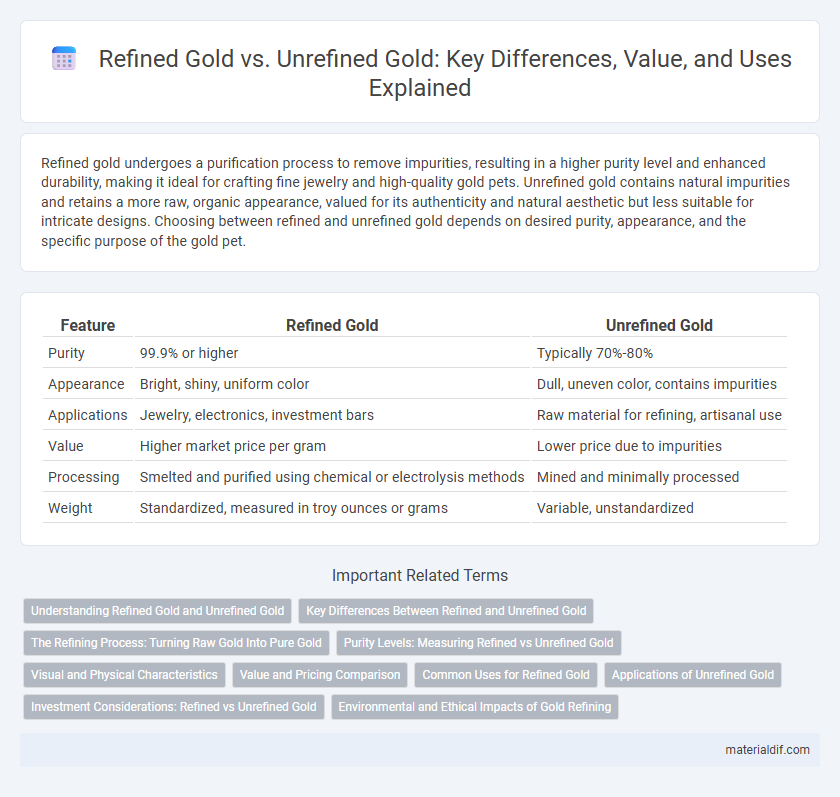Refined gold undergoes a purification process to remove impurities, resulting in a higher purity level and enhanced durability, making it ideal for crafting fine jewelry and high-quality gold pets. Unrefined gold contains natural impurities and retains a more raw, organic appearance, valued for its authenticity and natural aesthetic but less suitable for intricate designs. Choosing between refined and unrefined gold depends on desired purity, appearance, and the specific purpose of the gold pet.
Table of Comparison
| Feature | Refined Gold | Unrefined Gold |
|---|---|---|
| Purity | 99.9% or higher | Typically 70%-80% |
| Appearance | Bright, shiny, uniform color | Dull, uneven color, contains impurities |
| Applications | Jewelry, electronics, investment bars | Raw material for refining, artisanal use |
| Value | Higher market price per gram | Lower price due to impurities |
| Processing | Smelted and purified using chemical or electrolysis methods | Mined and minimally processed |
| Weight | Standardized, measured in troy ounces or grams | Variable, unstandardized |
Understanding Refined Gold and Unrefined Gold
Refined gold is processed through smelting and chemical treatments to remove impurities, resulting in high purity levels typically above 99.5%, ideal for jewelry and investment purposes. Unrefined gold, also called raw or natural gold, contains impurities like silver, copper, and other metals, making it less pure and suitable for initial extraction stages. Understanding the differences in purity, appearance, and usability helps investors and manufacturers make informed decisions about sourcing and application.
Key Differences Between Refined and Unrefined Gold
Refined gold undergoes extensive processing to remove impurities, resulting in a higher purity level typically above 99.5%, making it ideal for jewelry, electronics, and investment purposes. Unrefined gold contains natural impurities and is often found as gold ore or nuggets with variable purity, requiring further refining for commercial use. The key differences lie in purity, appearance, and suitability for industrial, commercial, or decorative applications.
The Refining Process: Turning Raw Gold Into Pure Gold
The refining process transforms unrefined gold, which contains impurities like dirt, metals, and other contaminants, into pure gold typically exceeding 99.9% purity. Techniques such as fire refining, electrolysis, and chemical leaching separate precious gold from alloyed metals and impurities, enhancing the metal's quality and usability in jewelry, electronics, and investment. Refined gold's high purity and consistent properties make it the preferred choice for trading on global markets and for precise industrial applications.
Purity Levels: Measuring Refined vs Unrefined Gold
Refined gold typically exhibits purity levels of 99.5% to 99.9%, achieved through processes like smelting and electrolysis that remove impurities and base metals. Unrefined gold, often called raw gold or gold ore, contains varying amounts of natural impurities such as silver, copper, and other metals, generally resulting in purity below 90%. Measuring purity involves techniques like fire assay and inductively coupled plasma mass spectrometry (ICP-MS), which precisely quantify gold content and distinguish between refined and unrefined samples.
Visual and Physical Characteristics
Refined gold exhibits a bright, uniform yellow color with a smooth, polished surface, indicating high purity and minimal impurities. Unrefined gold typically appears dull or tarnished, often mixed with other metals or minerals, resulting in a rougher texture and varying hues from reddish to greenish tones. The physical density of refined gold is consistently around 19.32 g/cm3, whereas unrefined gold's density may fluctuate due to the presence of impurities.
Value and Pricing Comparison
Refined gold commands higher value and pricing compared to unrefined gold due to its purity and lack of impurities, making it more desirable for investors and jewelers. Unrefined gold, containing other metals and minerals, typically sells at a discount because additional processing is required to extract pure gold. Market prices reflect these differences, with refined gold aligning closely to global spot gold rates, while unrefined gold trades below spot value based on impurity levels and processing costs.
Common Uses for Refined Gold
Refined gold is primarily used in the manufacturing of high-quality jewelry, electronics, and dental products due to its high purity and malleability. Its superior conductivity makes it indispensable for critical electronic components and connectors in smartphones, computers, and aerospace technology. Additionally, refined gold is widely utilized in investment products such as bullion bars and coins, ensuring consistent value and authenticity.
Applications of Unrefined Gold
Unrefined gold, containing impurities and other metals, is primarily used in industrial applications such as electronics, where its conductivity is valuable despite lower purity. It is also utilized in jewelry making, offering a natural and rustic aesthetic preferred in artisanal crafts. Additionally, unrefined gold serves as a raw material for further processing in metallurgy and chemical industries.
Investment Considerations: Refined vs Unrefined Gold
Refined gold offers higher purity levels, typically 99.9%, making it more liquid and widely accepted in global markets compared to unrefined gold, which contains impurities and requires processing. Investors prioritize refined gold for its consistent quality, easier valuation, and suitability for trading in bullion, coins, and jewelry markets. Unrefined gold may present opportunities for higher returns through refining but involves additional costs, risks, and longer timelines before becoming market-ready.
Environmental and Ethical Impacts of Gold Refining
Refined gold undergoes extensive chemical processing that can release hazardous pollutants like cyanide and mercury into water and soil, posing significant environmental risks. Unrefined gold extraction methods often involve artisanal mining with minimal regulation, leading to deforestation, habitat destruction, and unethical labor practices such as child labor and unsafe working conditions. Sustainable gold sourcing emphasizes responsibly mined, unrefined gold combined with modern refining technologies that reduce environmental damage and improve social accountability.
Refined Gold vs Unrefined Gold Infographic

 materialdif.com
materialdif.com